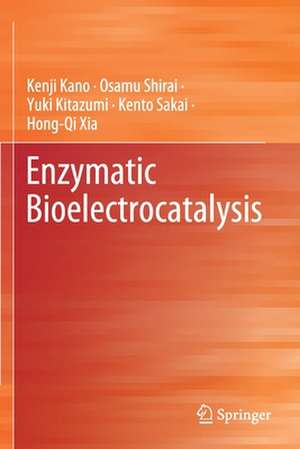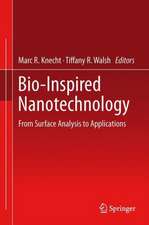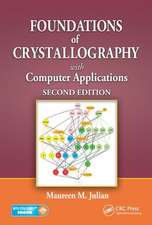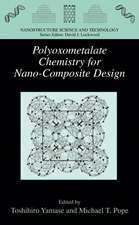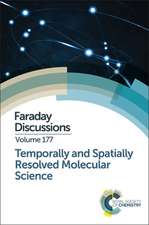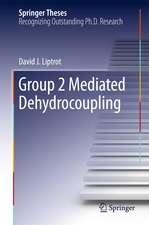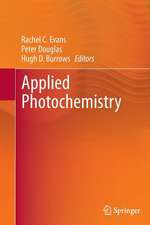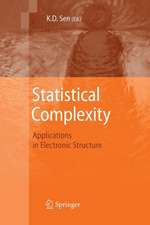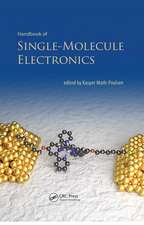Enzymatic Bioelectrocatalysis
Autor Kenji Kano, Osamu Shirai, Yuki Kitazumi, Kento Sakai, Hong-Qi Xiaen Limba Engleză Paperback – 14 noi 2021
This book covers the fundamental aspects of the electrochemistry and redox enzymes that underlie enzymatic bioelectrocatalysis, in which a redox enzyme reaction is coupled with an electrode reaction. Described here are the basic concept and theoretical aspects of bioelectrocatalysis and the various experimental techniques and materials used to study and characterize related problems. Also included are the various applications of bioelectrocatalysis to bioelectrochemical devices including biosensors, biofuel cells, and bioreactors. This book is a unique source of information in the area of enzymatic bioelectrocatalysis, approaching the subject from a cross-disciplinary point of view.
| Toate formatele și edițiile | Preț | Express |
|---|---|---|
| Paperback (1) | 672.23 lei 38-44 zile | |
| Springer Nature Singapore – 14 noi 2021 | 672.23 lei 38-44 zile | |
| Hardback (1) | 780.19 lei 43-57 zile | |
| Springer Nature Singapore – 14 noi 2020 | 780.19 lei 43-57 zile |
Preț: 672.23 lei
Preț vechi: 884.52 lei
-24% Nou
Puncte Express: 1008
Preț estimativ în valută:
128.64€ • 133.49$ • 107.53£
128.64€ • 133.49$ • 107.53£
Carte tipărită la comandă
Livrare economică 12-18 martie
Preluare comenzi: 021 569.72.76
Specificații
ISBN-13: 9789813340442
ISBN-10: 9813340444
Pagini: 135
Ilustrații: XIV, 135 p. 50 illus., 34 illus. in color.
Dimensiuni: 155 x 235 mm
Greutate: 0.22 kg
Ediția:1st ed. 2021
Editura: Springer Nature Singapore
Colecția Springer
Locul publicării:Singapore, Singapore
ISBN-10: 9813340444
Pagini: 135
Ilustrații: XIV, 135 p. 50 illus., 34 illus. in color.
Dimensiuni: 155 x 235 mm
Greutate: 0.22 kg
Ediția:1st ed. 2021
Editura: Springer Nature Singapore
Colecția Springer
Locul publicării:Singapore, Singapore
Cuprins
1. Introduction.- 2. DET-type bioelectrocatalysis.- 3. MET-type bioelectrocatalysis.- 4. Applications to biofuel cells and biosensors.- 5. Stability issues.- 6. Conclusions and outlooks.
Notă biografică
Kenji Kano is a Professor Emeritus at Kyoto University. Hewas born in 1954 in Japan and received his Ph.D. from the Department of Agricultural Chemistry, Faculty of Agriculture, Kyoto University, Japan, in 1983. He then worked for 12 years at Gifu Pharmaceutical University, Japan, as Assistant and Associate Professor. From 1990 to 1991, he joined as a visiting researcher with Prof. G. S. Wilson in Department Chemistry and Pharmaceutical Chemistry in Kansas University, USA. Since 1994, he was in Division of Applied Life Sciences in Graduated School of Agriculture, Kyoto University, where he was a Professor from 2005 to 2020. One of his recent research fields is bioelectrochemistry including enzymatic biofuel cells, biosensors, and bioreactors. The other field concerns physical and analytical biochemistry on redox enzymes. He has published around 330 research papers, 55 reviews, and 30 books. He has received 12 awards from academic societies in Japan on electrochemistry, analytical chemistry, and biochemistry. He has also obtained 17 patents on electrochemical devices and redox enzyme utilizations.
Textul de pe ultima copertă
This book covers the fundamental aspects of the electrochemistry and redox enzymes that underlie enzymatic bioelectrocatalysis, in which a redox enzyme reaction is coupled with an electrode reaction. Described here are the basic concept and theoretical aspects of bioelectrocatalysis and the various experimental techniques and materials used to study and characterize related problems. Also included are the various applications of bioelectrocatalysis to bioelectrochemical devices including biosensors, biofuel cells, and bioreactors. This book is a unique source of information in the area of enzymatic bioelectrocatalysis, approaching the subject from a cross-disciplinary point of view.
Caracteristici
Helps readers by providing detailed theoretical descriptions to easily characterize and optimize systems Includes many examples of redox enzymes and materials that are useful for readers to construct related systems Inspires readers’ interest in this field with several applications of bioelectrocatalysis
